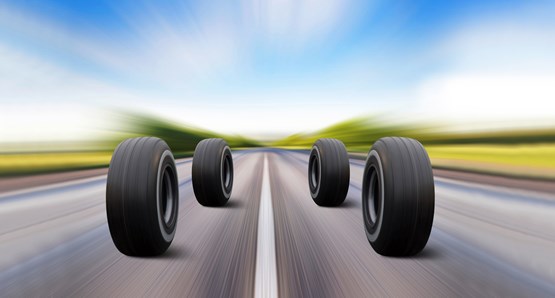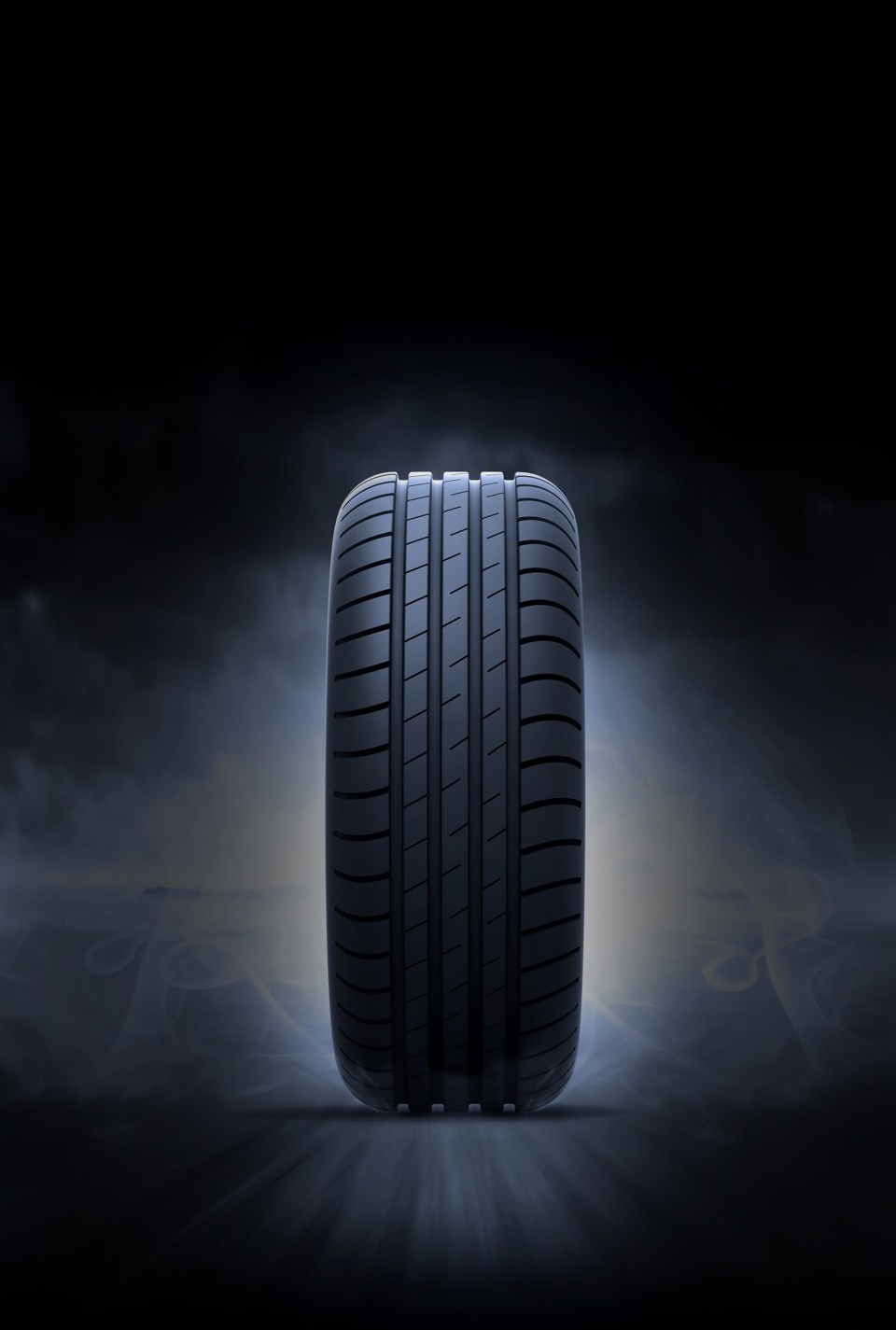Research and development is essential in the hunt for longer tyre life, but further savings on price remain elusive, John Lewis reports.
If a company wants to stay ahead of the competition in the hotly-contested van and truck tyre sector it has got to be willing to spend money on research and development.
“The double-digit improvement in tyre life we’re achieving is a direct result of our annual investment of more than €700m (£630m) in R&D,” says Michelin marketing director, north Europe, truck and bus, Chris Smith.
He is thinking in particular about the X Multi truck line-up which made its global debut at the Commercial Vehicle Show back in April.
Aimed at operators on regional and national transport work rather than international hauliers, the newcomers deliver 15% to 20% more mileage than the X MultiWay 3D tyres they are replacing.

The X Multi range includes four key fitments: 315/70 R22.5 multi-position and drive axle tyres and 385/55 R22.5 steer and trailer tyres.
Other sizes will be rolled out during the course of this year and in 2018.
The 315/70 size is gradually displacing the long-established 295/80 R22.5 because it is better able to support the additional weight burden imposed by the arrival of Euro VI.
Figures released by the European Tyre & Rubber Manufacturers’ Association reveal replacement demand for 295/80 R22.5 has declined 3% in the UK since 2010 while 315/70 has increased its share by 3.4% and the 315/80 R22.5 by 0.6%.
The trend has accelerated over the past two or three years, says Michelin.
“It’s one of the most notable changes in tyre-buying habits we’ve seen this side of the millennium,” says UK commercial director, Guy Heywood.
Michelin has taken a variety of steps aimed at boosting X Multi’s longevity. They include Regenion technology which, it says, has been made possible by 3D metal printing.
It allows the moulding of self-generating tread blocks which include hidden grooves that appear as the tread wears down.
They ensure grip and traction are maintained at an optimum level throughout the tyre’s life, says the manufacturer.

Regenion results in a tyre pattern which is more closed and rigid. As a consequence the tread’s contact patch with the road surface is optimised which slows the wear rate and increases the mileage potential.
Another way of achieving the same goal is increasing the tread area; now 6mm wider on some X Multi models.
Michelin is also employing InfiniCoil. It denotes a continuous steel wire up to an astonishing 400m in length wrapped around the tyre’s crown in a bid to provide greater stability and durability.
Yet another feature is the Carbion compound, a blend of rubber said to provide greater resistance to abrasion along with reduced rolling resistance and – once again – better mileage potential.
Perhaps one of the most significant features of X Multi, however, is the presence of an integrated radio-frequency identification (RFID) chip.
It makes it easier to identify and trace each tyre from manufacture, through re-grooving and re-treading, to the point at which the carcass faces disposal.

Making tyres more intelligent is one of Continental’s ambitions. It offers iTire truck tyres which come with ContiPressureCheck pressure sensors installed at the factory.
The data they record is displayed on a screen in the cab with the driver receiving an alert if it deviates from the target value.
Where a telematics system is fitted, the sensor’s readings can be transmitted to the transport manager.
Last year’s IAA Commercial Vehicle Show in Hanover, Germany, saw Continental introduce ContiConnect.
It can monitor and analyse all the information derived from the ContiPressureCheck sensors for an entire fleet with reports provided through an online portal.
The sensors can deliver temperature as well as pressure data.

Goodyear offers a similar system called Proactive Solutions. While Bridgestone offers remote pressure monitoring through its Tirematics sensors-and-gate system.
It can be set up in such a way that special valves on a vehicle’s tyres send pressure data via the GSM network to the Bridgestone fleet data server every time a van or truck drives in and out of a fleet operator’s premises.
The data is evaluated in real time and an email is automatically dispatched to the fleet and its service provider if pressures fall outside pre-defined limits.
Some fleets using Tirematics technology have reported a 75% fall in tyre-related roadside breakdowns, says Bridgestone, plus a 0.5% fuel saving thanks to better pressure maintenance.
Mining the data provided by Tirematics, which is now undergoing additional development, could benefit customers further suggests Neil Purves, senior manager, solution business systems, at Bridgestone Europe.
“It could allow optimal tyre selection for a particular fleet operation,” he says.

Michelin points out that a tyre that is 20% under-inflated will typically return 20% less mileage before needing to be replaced.
Neglecting pressures can worsen fuel economy by 20% adds ATS Euromaster and detrimentally affects ride, handling and braking distances.
Many of the technical enhancements featured in Michelin’s X-Multi have already appeared in its X Line Energy range.
It was expanded last year, with six new fitments said to offer up to 30% better mileage.
With X Line, the stress is on low rolling resistance, with fuel savings of up to 2.5 litres per 100km promised when the latest fitments are new.
It should be stressed, however, that optimum savings can only be achieved when trucks are travelling at a steady speed on the motorway for hour after hour; not when they are crawling around, say, the M25 in heavy traffic.
Last year’s IAA exhibition saw Goodyear introduce prototype low-rolling-resistance truck tyres under the Super Fuelmax banner, initially in 385/55 R22.5 steer and 315/70 R22.5 drive sizes.
The savings they purport to offer wins an A grade so far as the European Union’s tyre labels are concerned.
A key reason why they contribute to lower fuel usage, Goodyear says, is because the tread compound makes extensive use of a formulation based on silica.
Employing it instead of traditional carbon black cuts rolling resistance but need not affect grip or tread life. Stiffer treads have helped, too.
Potential for 10,000kms more

A new silica tread compound and a re-designed tread pattern both figure highly in Goodyear’s EfficientGrip Cargo van tyre, which was launched last October.
They mean it potentially offers 10,000kms more than its predecessor says the company.
Rolling resistance has been cut by up to 18%, because a stiffer base compound coupled with a cool cushion layer means Efficient Cargo generates less heat than the Cargo Marathon it has replaced.
Technical progress is not the monopoly of the premium brands. Singapore-based Giti Tire is making steady progress in the UK and has just launched two new tyres aimed at trucks that regularly access landfills and construction sites.
The all-position GAM837 (295/80, 315/70 R22.5) and the GAM851 (385/65 R22.5) for steer and trailer applications both feature anti-cut and chip compounds designed to resist tearing and other damage if they are driven across rough, uneven surfaces. Other sizes will be released.
Technical developments can have a major impact on fleet practices. British Gas, for example, fits Michelin’s CrossClimate tyres to its 13,000-strong van-dominated commercial vehicle fleet rather than swapping winter tyres for summer ones then back again dependent on the time of year.
The tyres can cope with hot, dry roads in summer and cold, wet – and potentially snow-covered – roads in winter without performance suffering.
CrossClimate delivers all the grip the drivers need. It comes with a V-shaped tread and sipes (grooves) which lock the tread blocks on the tyre’s surface closely together when they contact the road.
The aim is to improve handling when cornering or evading obstacles.

Does that mean winter tyres are obsolete? That is certainly not the view of Continental, which launched the VanContact Winter 18 months ago.
Continental claims it offers a 5% improvement in performance when the driver brakes on snow compared with its predecessor, a 9% improvement when they brake on wet roads and a 15% reduction in rolling resistance.
Rolling resistance is down because of a silica compound which lessens the deformation of the tyre’s road contact patch. Energy loss is reduced as a result, says Continental.
Sipes have been used in the centre of the tread and the shoulder blocks to increase the number of gripping edges.
Zig-zag circumferential grooves and evenly-spaced pockets in the shoulder blocks improve the compression of snow in the grooves which also makes for better grip.
In an ideal world technological improvements would result in products that costs the same or only a little more, but last longer.
The tyre industry does not inhabit an ideal world, however. Any technology-inspired savings have been more than offset by rising raw material prices and the fall of sterling in the wake of last year’s Brexit vote.
“Most tyre manufacturers have put their prices up by between 8% and 12% during the 12 months spanning the second half of last year and the first half of this,” says Bridgestone UK commercial sales director Greg Ward.
The drop in sterling has benefited mainstream manufacturers because it has resulted in a fall in imports of cheap tyres with obscure brand names shipped in from the Far East.
It has also benefited truck tyre retreaders whose products can compete more effectively with budget-brand new tyres which have now gone up in price.
“One of our Remix retreads is 60% of the cost of a new tyre,” Michelin’s Smith points out. Michelin makes its retreads in Stoke-on-Trent.
Steel and rubber prices increase
The raw materials that have risen in price include steel and natural rubber.

“Remember that while a new truck tyre weighs 65kg to 70kg, a retread only requires 20kg of fresh raw material before it can go back into service,” says Bridgestone retread development manager, Terry Salter.
“That’s a big saving.”
Bridgestone has a retreading plant in Bourne, Lincolnshire, which can produce around 80,000 retreads annually.
Like new tyre manufacturers, retreaders are continuing to develop and refine their products.
Launched at this year’s Commercial Vehicle Show, Vacu-Lug’s 245/70 R17.5 WZY2 has been provided with extra protection against kerb damage, with five ribs moulded into its upper sidewall.
The usual solid sidewall protectors can be too rigid, it says, leading to unwanted heat build-up, and can have high abrasion rates because they are not capable of fully deflecting repeated impacts from solid surfaces.
Vacu-Lug’s factory is also in Lincolnshire, outside Grantham.
Re-treading – not always possible with cheap imports – and re-grooving both play a key role in truck tyre management packages. “Re-grooving can extend a tyre’s life by around 25%,” Smith points out.
That is something recognised by Bridgestone’s Total Tyre Care programme.
Delivered through 90 independent dealers with 400 outlets nationwide backed by Bridgestone’s own audit team, it covers everything from checking pressures regularly and, if necessary, altering them to ensuring tyres are not swapped prematurely.
Manufacturers are usually happy to advise van and truck fleets on which tyres are the most suitable for their vehicles based on the work they are involved in.
Hankook can carry out a fleet audit that assesses the general condition of the tyres in service, identifies any abnormal wear or damage issues and takes note of the customer’s favoured approach to maintenance.
It can offer advice on suitable tyre sizes and patterns, whether new tyres or retreads should be fitted, how often tyres should be replaced and what the regrooving policy should be.
Almost all tyre manufacturers rely heavily on dealers to provide truck operators with the products they need. There is one that does not.
Making its European truck tyre debut at this year’s Commercial Vehicle Show, Apollo Tyres has taken the unusual step of marketing its products solely online both to end-users and to dealers.
The advantages include transparent pricing and reduced overheads, it says.

Though not a familiar name in the UK as yet, India’s Apollo has a presence in more than 100 countries, a global workforce of around 16,000 and achieved a £1.49 billion turnover in 2017. It owns the Vredestein brand.
The company opened a £432m plant in Hungary in April. Other European facilities include an R&D centre in the Netherlands opened in 2013.
The range launched at the CV Show was developed specifically for Europe over the preceding five years, says Apollo group head of global product management for commercial vehicles Benoit Rivallant.
“It was tested over 250m kilometres across six European countries in a wide range of applications by around 50 fleets,” he says.
Testing by fleet operators is, of course, the key way of proving – or disproving – claims made by manufacturers.
Steel waste container specialist Fairport Containers recently trialled a set of Michelin 315/70 R22.5 X MultiWay 3D XDE drive tyres against a set of tyres from an un-named budget manufacturer.
The Michelins clocked up almost 383,000 kilometres before they reached a tread depth of 3mm – the point at which Fairport replaces its tyres – compared with 132,000km for the budget fitments.
“Buy budget tyres and you think you’re saving money, but it was actually quite the reverse,” says Fairport service manager, Lee Cunliffe.
“In reality they were hitting us hard in the pocket so a switch to premium products after comparing the trial data was a no-brainer.”
Diminishing budget brand challenge
Michelin has pursued an innovative approach to combating the – for the present, somewhat diminished – challenge posed by budget brands by providing an accidental damage guarantee with all its regional and construction industry replacement truck tyres.
All the customer has to do is register the tyre on a web portal within a month of purchase.
What does the future hold for commercial vehicle tyre development?
There is undoubtedly a need to switch away from materials that are non-renewable and in some cases damage the environment during production.
The answer could lie with Taraxagum says Continental – rubber made from, of all things, dandelion roots.
CV tyres, engine mounts and prop shaft bearings made from Taraxagum were all shown at the IAA last year.
“Over the next five years we intend to invest €35m (more than £30m) to explore the production process further,” says Continental Tyres chairman Burkhardt Koller.
This article is sponsored by Apollo



















Login to comment
Comments
No comments have been made yet.